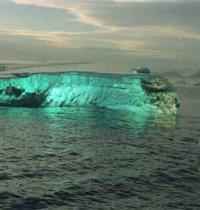 While most icebergs are whiteish-blue, they can be a range of colors, including emerald green. Indeed, in Samuel Coleridge’s Rime of the Ancient Mariner, the mariner describes how “ice, mast-high, came floating by, as green as emerald.”
While most icebergs are whiteish-blue, they can be a range of colors, including emerald green. Indeed, in Samuel Coleridge’s Rime of the Ancient Mariner, the mariner describes how “ice, mast-high, came floating by, as green as emerald.”
Why are some icebergs green? In time for St. Patrick’s Day, a paper in the American Geophysical Union journal JGR Oceans, titled “Green Icebergs Revisited” by researchers led by Stephen Warren, a glaciologist and emeritus professor at the University of Washington, offers a new theory about how these verdant icebergs come to be.
Icebergs can begin as chunks of glacial ice sheets which break off and drift into the ocean. They are the same colors as the glacier itself, usually a white to bluish white. Seawater freezes to the base of some ice shelves, forming marine ice. The marine ice carries with it organic compounds. The paper notes that the marine‐ice part of such icebergs is clear, dark, and often green in color, because red or yellow particles from the seawater, in combination with the blue of ice, can shift the color to green. The marine ice portion of the iceberg becomes most visible if the iceberg capsizes.
It had been thought that dissolved organic carbon may be responsible for the green color. Recent research suggests otherwise. The finding of large concentrations of iron in marine ice from the Amery Ice Shelf suggests that the color of green icebergs may be caused by iron‐oxide minerals.
Whatever color your iceberg may be, Happy St. Patrick’s Day.
